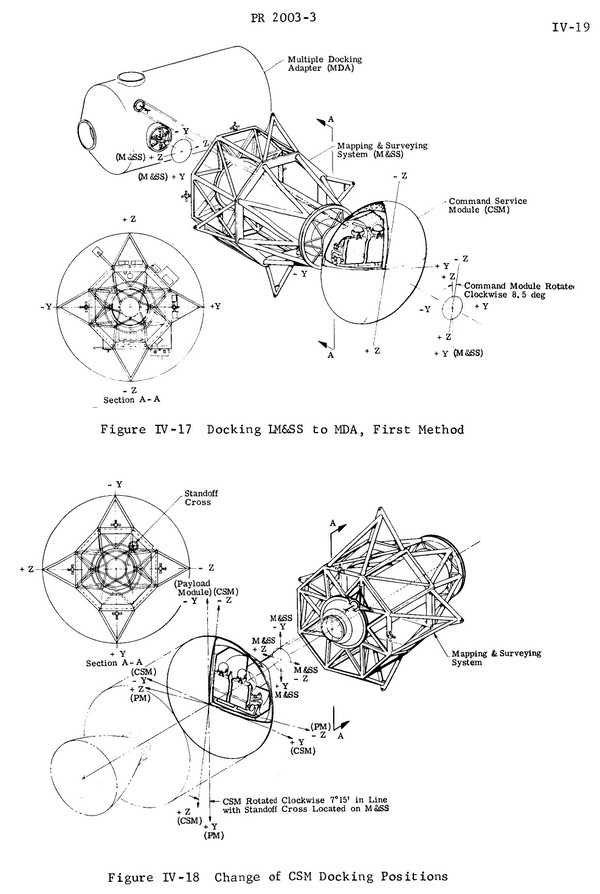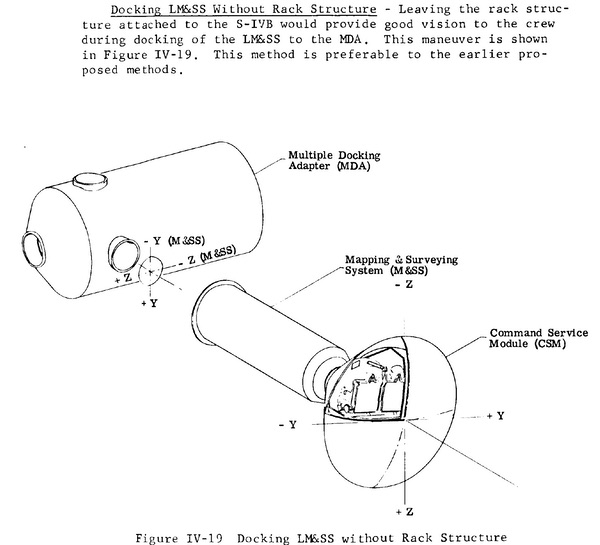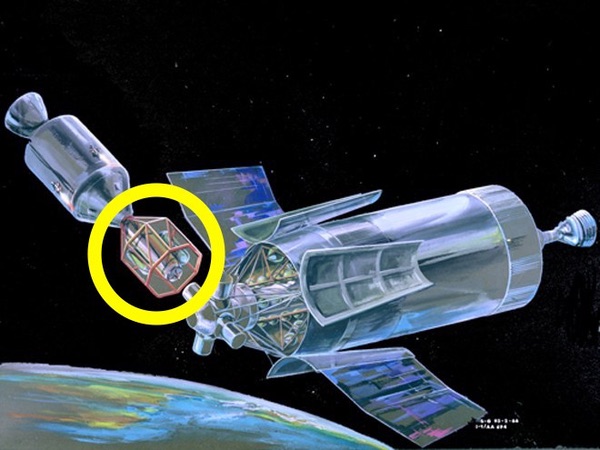Strange bedfellowsby Dwayne A. Day
|
| The UPWARD declassification demonstrated that the Apollo program had—and may still have—secrets to reveal. |
UPWARD was a project to convert an obsolete KH-7 GAMBIT-1 reconnaissance satellite camera for use supporting the Apollo program. Initial plans were to fit the large camera inside one of the Scientific Instrument Module compartments on the side of the Apollo Service Module. But for reasons that remain unclear, program managers later changed the plan to mounting the camera inside the cylindrical shell for the GAMBIT-1’s successor, the KH-8 GAMBIT-3, and mounting it inside a Saturn V in the location where a Lunar Module would normally go. The astronauts would separate their Command/Service Module from the Saturn S-IVB third stage, rotate around, and dock with the UPWARD spacecraft, pulling it free. Once in lunar orbit, they would turn it on and take high resolution photos of various possible landing sites. But UPWARD was only an insurance policy, a backup in case the robotic Lunar Orbiter spacecraft failed to produce adequate photos for landing site selection. At least that was the plan. NASA officials soon developed other ideas, and NRO officials got nervous.
UPWARD was started in spring 1964 and officially canceled by spring 1967 after initial hardware had been built and was nearing thermal and vacuum testing for flight. What makes UPWARD such a fascinating program are three unique factors. First, until it was partially declassified starting in 2010 and more fully declassified in 2012, UPWARD was unknown. It was not discussed in Apollo histories written in the four decades after the program ended. There were no leaks about it, despite it being a real project with actual hardware built. The UPWARD declassification demonstrated that the Apollo program had—and may still have—secrets to reveal.
Second, although UPWARD was classified, it had a public face as the Lunar Mapping and Survey System, or LMSS, sometimes reduced to simply MSS. People without security clearances and the need to know technical details about the spacecraft would still have to know of the existence of a special mission that Apollo might have to conduct, and so the existence of the LMSS was public, although not highly publicized. LMSS/MSS appeared in some NASA documents, without any explanation beyond its name. Despite this, for decades journalists and space historians didn’t grab at that string to try and find out what was at the other end.
 Diagrams of how to mount the MSS to the Apollo Applications Program space station |
The third reason that UPWARD/LMSS so interesting is that its history reads like a drama of a failing marriage. It’s a tale of people from two government agencies with different missions and outlooks trying to cooperate. What becomes evident upon reading declassified UPWARD documents is that, over time, NRO officials became increasingly uneasy about what NASA wanted to do with the UPWARD camera. Before sending it to the Moon, NASA officials wanted to test it in Earth orbit, soon becoming so enamored of its capabilities that they decided they wanted to operate it connected to an Earth-orbiting space station as part of the Apollo Applications Program (AAP). NASA’s charter included studying the Earth, and the MSS camera was a powerful instrument for doing exactly that. NRO’s mission included maintaining the secrecy of the powerful reconnaissance systems used to gather intelligence about America’s adversaries. Unless the UPWARD system was absolutely necessary for supporting Apollo landings, NRO officials believed it should be canceled and buried. Similar dramas occurred over other programs, most notably the Space Shuttle a decade later, but that one still remains shrouded in secrecy.
| Its history reads like a drama of a failing marriage. It’s a tale of people from two government agencies with different missions and outlooks trying to cooperate. |
By late 1966 and early 1967, NASA was evaluating how to incorporate the MSS into a planned Apollo Applications Program flight. An April 1967 report by the Martin Marietta Corporation addressed integrating payloads into an early AAP mission and depicted how the MSS (no “L” since it was only going to be in Earth orbit) could be attached to the space station. Several illustrations in the report depict MSS inside a large truss structure that would hold it inside the Saturn Launch Adapter. Other illustrations show no truss structure. Although some kind of structure would have been required to carry the LMSS/MSS inside the Saturn, at the time engineers had not decided if it was possible to pull the large camera out of the truss, or if they would leave it attached. For Earth orbit operations, the mass penalty would have been unimportant, but the truss would obscure the Command Module pilot’s vision and made it harder to attach to the space station. It probably would also have been easier to maneuver the Command/Service Module without the mass of the truss.
 Diagrams of how to mount the MSS to the Apollo Applications Program space station |
Even that truss structure proved to be a source of contention between NASA and the NRO. NASA wanted to build it in-house, in Huntsville, believing that NASA personnel would best know how to integrate NASA hardware. The NRO wanted their trusted contractor Lockheed to build it, concerned that too many NASA people involved in UPWARD would lead to leaks.
One day before the Apollo 1 fire NASA officials held a press conference outlining plans for the Apollo Application Program. MSS was briefly mentioned as an AAP payload. After the fire, plans for AAP changed dramatically and soon the MSS was canceled and never spoken about again. But it undoubtedly left NRO officials slightly scarred, wary of working with an agency that liked to talk about its missions in front of reporters and didn’t have the same reverence for secrecy that the intelligence community had.
Note: we are temporarily moderating all comments submitted to deal with a surge in spam.
